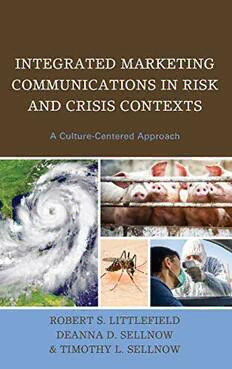Table Of ContentIntegrated Marketing
Communications in Risk
and Crisis Contexts
Integrated Marketing Communication
Series Editor: Jeanne M. Persuit
University of North Carolina Wilmington
Integrated marketing communication (IMC) is a holistic approach to the areas of
advertising, public relations, branding, promotions, event and experiential marketing,
and related fields of strategic communication. This series seeks to ground IMC with
communication ethics in order to take the theory and practice of IMC beyond a critical
and deconstructive understanding and into new areas of productive inquiry. We seek
to advance the scholarship of IMC in a manner that influences and informs future
practice. Submissions may rely on varied methodologies and relate to the study and
practice of communication and its theoretical diversity, including but not limited to the
areas of rhetoric, visual communication, media ecology, philosophy of communication,
mass communication, intercultural communication, and instructional communication.
We welcome submissions addressing all facets of IMC and its relationship with
communication ethics. While edited volumes will be considered, we encourage the
submission of scholarly monographs that explore, in-depth, issues in IMC as related to
communication ethics.
Titles in the series:
Integrated Marketing Communications in Risk and Crisis Contexts: A Culture-Centered
Approach
By Robert S. Littlefield, Deanna D. Sellnow, and Timothy L. Sellnow
Integrated Marketing Communication: Celebrity and the American Political Process
By Jennifer Brubaker
Sport Teams, Fans, and Twitter: The Influence of Social Media on Relationships and
Branding
By Brandi Watkins
Integrated Marketing Communication: Creating Spaces for Engagement
Edited by Jeanne M. Persuit & Christina L. McDowell Marinchak
Integrated Marketing
Communications in Risk
and Crisis Contexts
A Culture-Centered Approach
Robert S. Littlefield, Deanna D. Sellnow, and
Timothy L. Sellnow
LEXINGTON BOOKS
Lanham • Boulder • New York • London
Published by Lexington Books
An imprint of The Rowman & Littlefield Publishing Group, Inc.
4501 Forbes Boulevard, Suite 200, Lanham, Maryland 20706
www .rowman .com
6 Tinworth Street, London SE11 5AL, United Kingdom
Copyright © 2021 The Rowman & Littlefield Publishing Group, Inc.
All rights reserved. No part of this book may be reproduced in any form or by any
electronic or mechanical means, including information storage and retrieval systems,
without written permission from the publisher, except by a reviewer who may quote
passages in a review.
British Library Cataloguing in Publication Information Available
Library of Congress Cataloging-in-Publication Data
Library of Congress Control Number: 2020950416
∞ ™ The paper used in this publication meets the minimum requirements of American
National Standard for Information Sciences—Permanence of Paper for Printed Library
Materials, ANSI/NISO Z39.48-1992.
Contents
List of Illustrations vii
Acknowledgments ix
Introduction 1
1 Situating Culture and Integrated Marketing in Risk and Crisis
Communication 7
2 The Cultural Imperative in Risk and Crisis Communication Best
Practices 27
3 Building the Cultural Model of Risk and Crisis Communication 41
4 The IDEA Model of Instructional Risk and Crisis Communication 59
5 The Culture-Neutral Approach 75
6 The Culturally Sensitive Approach 91
7 The Culture-Centered Approach 109
8 Implications of Emphasizing Culture in Risk and Crisis
Communication 123
9 The Need for an Ethical Framework 145
10 Future Directions for Situating Culture in Risk and Crisis
Communication 163
v
vi Contents
References 173
Index 191
About the Authors 199
List of Illustrations
FIGURES
1.1 Stages of Integrated Marketing Communications 12
1.2 Single Spokesperson Model of Crisis Communication 21
1.3 Multiple Spokesperson Model of Crisis Communication 22
2.1 Risk and Crisis Communication Best Practices 29
4.1 Symbolic of Most Serious Warnings in Western Cultures 62
4.2 Symbolic of Most Dangerous Weather Condition 63
4.3 Drop, Cover, Hold On Action Step Exemplar 68
4.4 How to Help 69
6.1 Hurricane Dorian Probable Path of the Storm 100
6.2 Hurricane Dorian Spaghetti Model 103
7.1 Culture-Centered Unlimited Feedback Model 112
7.2 Culture-Centered Multiple Spokesperson Model of Crisis
Communication 114
8.1 Involvement of Cultural Agents in Stages of Integrated
Marketing Communications 126
TABLES
2.1 Comparison of Strategic Planning Best Practices with Stage 1
of Integrated Marketing Communications 32
2.2 Comparison of Inclusive Approach Best Practices with Stage
2 of Integrated Marketing Communications 33
2.3 Comparison of Responsible Communication Best Practices
with Stage 3 Integrated Marketing Communications 34
vii
viii List of Illustrations
2.4 Comparison of Corrective Action Best Practices with Stage 4
Integrated Marketing Communications 35
3.1 Perspectives of Control of Cultural Characteristics on
Approaches to Risk and Crisis Communication 53
3.2 Timeline of Public Communication about ZIKv Outbreak 55
3.3 Timeline of Hurricane Dorian 56
3.4 Timeline of PEDv and ASFv Outbreaks 58
6.1 Location of Land Areas Directly Affected by Hurricane Dorian 98
6.2 Examples of Emotive Language Used by NHC 101
6.3 Weather Warnings Included in NHC Bulletins and
Their Meanings 104
8.1 Comparison of Communication Elements in Cultural-Neutral,
Culturally Sensitive, and Culture-Centered Approaches 127
Acknowledgments
We thank Dr. Jeanne Persuit for helping us to conceptualize our book pro-
posal and the final product. She is a leader in IMC research and her insights
have been valuable throughout the writing process. We acknowledge the
support of colleagues at the University of Vermont, the University of Central
Florida (UCF), and North Dakota State University where the five-year NIFA
Coordinated Agriculture Project of the U.S. Department of Agriculture enti-
tled “A Human Behavioral Approach to Reducing the Impact of Livestock
Pest or Disease Incursions of Socio-economic Importance,” was supported,
under award number 2015-69004-23273. Victor Martinez Rivera in the
Nicholson School of Communication and Media at UCF provided creative
expertise; and a final word of appreciation is extended to Kathy Littlefield for
her encouragement, patience, and support throughout the project.
ix

